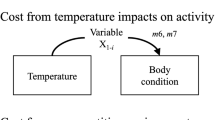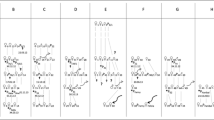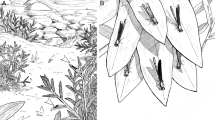Summary
Male tree lizards (Urosaurus ornatus) abandon their territories following the removal of potential mates. Departure time averages 25 days but varies from 1 to 7 weeks. We show that most of the variation (r 2=0.78) in departure of males can be accounted for by the number of females removed from male territories and adjacent trees. Males occupying higher quality territories (more potential mates) have short departure times, whereas males on poorer territories (fewer fameles) stay longer after female removal. We hypothesize that the inverse relationship between male departure time and the number of females removed from their territories is a consequence of the male's previous expectation of envountering prospective mates. In addition, experimental introduction of non-resident males into the territories of resident males revealed the inability of intruder males to become established on occupied territories.
Similar content being viewed by others
References
Asplund KK, Lowe CH (1964) Reproductive cycles of the iguanid lizards Urosaurus ornatus and Uta stansburiana in southeastern Arizona. J Morph 115:27–34
Carlson A, Moreno J (1982) The loading effect in central place foraging wheatears Oenanthe oenanthe L. Behav Ecol Sociobiol 11:173–184
Charnov EL (1976) Optimal foraging: the marginal value theorem. Theor Popul Biol 9:129–139
Cowie RJ (1977) Optimal foraging in great tits Parus major. Nature 268:137–139
Davies NB (1978) Ecological questions about territorial behavior. In: Krebs JR, Davies NB (eds) Behavioral ecology: an evolutionary approach, Sinauer, Massachusetts, pp 317–350
Davies NB, Houston AI (1983) Time allocation between territories and flocks and owner-satellite conflict in foraging pied wagtails, Motacilla alba. J Anim Ecol 52:621–634
Davies NB, Lundberg A (1984) Food distribution and a variable mating system in the dunnock, Prunella modularis. J Anim Ecol 53:895–912
Davis J, Ford RG (1983) Home range in the western fence lizard (Sceloporus occidentalis occidentalis). Copeia 1983:933–940
Emlen ST, Oring LW (1977) Ecology, sexual selection, and the evolution of mating systems. Science 197:215–223
Howard RD (1978) Factors influencing early embryo mortality in bullfrogs. Ecology 59:789–798
Kiester AR, Slatkin M (1974) A strategy of movement and resource utilization. Theor Pop Biol 6:1–20
M'Closkey RT, Baia KA, Russell RW (1987) Tree lizard (Urosaurus ornatus) territories: experimental perturbation of the sex ratio. Ecology (in press)
Parker GA (1978) Searching for mates. In: Krebs JR, Davies NB (eds) Behavioural ecology: an evolutionary approach, Sinauer, Massachusetts, pp 214–244
Pleszczynska W, Hansell RIC (1980) Polygyny and decision theory: testing of a model in lark buntings (Calamospiza melanocorys). Am Nat 116:821–830
Smith JWM, Yom-Tov, Y, Moses R (1982) Polygyny, male parental care, and sex ratio in song sparrows: an experimental study. Auk 99:555–564
Stamps JA (1983) Sexual selection, sexual dimorphism, and territoriality. In: Huey RB, Pianka ER, Schoener TW (eds) Lizard ecology, studies of a model organism, Harvard University press, Massachusetts, pp 169–204
Stamps JA, Tollestrup K (1984) Prospective resource defense in a territorial species. Am Nat 123:99–114
Trivers RL (1976) Sexual selection and resource-accruing abilities in Anolis garmani. Evolution 30:253–269
Vehrencamp SL, Bradbury JW (1983) Mating systems and ecology. In: Krebs JR, Davies NB (eds) Behavioural ecology: an evolutionary approach, Sinauer, Massachusetts pp 251–278.
Verner J (1964) Evolution of polygamy in the long-billed marsh wren. Evolution 18:252–261
Weatherhead PJ, Robertson RJ (1977) Harem size, territory quality, and reproductive success in the redwinged black-bird (Agelaius phoeniceus). Can J Zool 55:1261–1267
Wittenberger JF (1980) Food supply, vegetation structure and polygyny in bobolinks, Dolichonyx oryzivores. Ecology 61:140–150
Author information
Authors and Affiliations
Rights and permissions
About this article
Cite this article
M'Closkey, R.T., Baia, K.A. & Russell, R.W. Defense of mates: a territory departure rule for male tree lizards following sex-ratio manipulation. Oecologia 73, 28–31 (1987). https://doi.org/10.1007/BF00376973
Received:
Issue Date:
DOI: https://doi.org/10.1007/BF00376973




